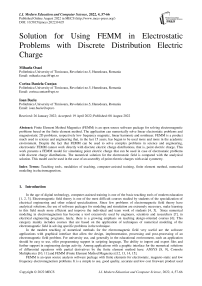Solution for Using FEMM in Electrostatic Problems with Discrete Distribution Electric Charge
Автор: Mihaela Osaci, Corina Daniela Cunțan, Ioan Baciu
Журнал: International Journal of Modern Education and Computer Science @ijmecs
Статья в выпуске: 4 vol.14, 2022 года.
Бесплатный доступ
Finite Element Method Magnetics (FEMM) is an open source software package for solving electromagnetic problems based on the finite element method. The application can numerically solve linear electrostatic problems and magnetostatic 2D problems, respectively low frequency magnetic, linear harmonic and nonlinear. FEMM is a product much used in science and engineering that, in the last 15 years, has begun to be used more and more in the academic environment. Despite the fact that FEMM can be used to solve complex problems in science and engineering, electrostatic FEMM cannot work directly with discrete electric charge distributions, that is, point electric charge. This work presents a FEMM model for simulating point electric charge that can be used in case of electrostatic problems with discrete charge distributions. The numerical solution for the electrostatic field is compared with the analytical solution. This model can be used in the case of an assembly of point electric charges with axial symmetry.
Teaching tools, modalities of teaching, computer-assisted training, finite element method, numerical modeling in electromagnetism
Короткий адрес: https://sciup.org/15018528
IDR: 15018528 | DOI: 10.5815/ijmecs.2022.04.05
Список литературы Solution for Using FEMM in Electrostatic Problems with Discrete Distribution Electric Charge
- Y. Kong and I. Xie, “Professional Courses for Computer Engineering Education”, I. J. Modern Education and Computer Science, 1, pp.1-8, 2010.
- A. Herala, A. Knutas, E. Vanhalan and J. Kasurinen, “Experiences from Video Lectures in Software Engineering Education”, International Journal of Modern Education and Computer Science, Vol.9, No.5, 2017.
- M. Mladenović, M. Rosić and S. Mladenović, “Comparing Elementary Students' Programming Success based on Programming Environment”, International Journal of Modern Education and Computer Science, Vol. 8, No. 8, 2016.
- K. K. Krutikov and V. V. Rozhkov, “Features of Electrical and Magnetic Skin Effect Modeling from Alternating Electromagnetic Fields in FEMM”, Russian Electrical Engineering, Vol. 91, pp. 781–785, 2020
- K.G. Brandisky, K.P. Stanchev, I.I. lacheva, R.D. Stancheva, S.K. Petrakieva, S.D. Terzieva, V.M. Mladenov, “Computer-Aided Education in Theoretical Electrical Engineering at the Technical University of Sofia: Part II”, in EUROCON 2005 - The International Conference on "Computer as a Tool", 2005
- D. Kacprzak, P. Surdacki, H.D. Stryczewska, B. Guillemin, “Magnetic modelling projects in university courses - New Zealand and polish examples”, in IET 7th International Conference on Computation in Electromagnetics (CEM 2008), pp. 66 – 67, 2008
- D. Kacprzak, “Implementation of Finite Element Method Modelling Tools in Education Programs”, in 6th International Conference on Computational Electromagnetics, 2006
- “ANSYS”, [Online]. Available: https://www.ansys.com/. [Accessed 2 March 2022]
- T. Stolarski, Y. Nakasone, S. Yoshimoto, Engineering Analysis with ANSYS Software, second edition, Elsevier Publishing House, 2018
- W. B. J. Zimmerman, “Comsol Multiphysics and the Basics of Numerical Analysis”, Series on Stability, Vibration and Control of Systems, Series A: Vol. 18 -Multiphysics Modeling with Finite Element Methods, pp. 27-63, 2006
- “COMSOL”, [Online]. Available: https://www.comsol.com/. [Accessed 2 March 2022]
- “FEMM-homepage”, [Online]. Available: https://www.femm.info/wiki/HomePage. [Accessed 2 March 2022]
- K. B. Baltzis, “The finite element method magnetics (FEMM) freeware package: May it serve as an educational tool in teaching electromagnetics?”, Education and Information Technologies, vol. 15(1), pp.19-36, 2010
- K. B. Baltzis, “On the usage and potential applications of the finite element method magnetics (FEMM) package in the teaching of electromagnetics in higher education”, in 8th International Conference on Computer Based Learning in Science (CBLIS 2007), 2007
- R. Crozier and M. Mueller, “A new Matlab and Octave interface to a popular magnetics finite element code”, in XXII International Conference on Electrical Machines (ICEM), 2016
- L. Hao, L. Xue, F. Huang, G. Cai, W. Qi, M. Zhang, Q. Han, Z. Wang, J. Lin, “A Microfluidic Biosensor Based on Magnetic Nanoparticle Separation, Quantum Dots Labeling and MnO2 Nanoflower Amplification for Rapid and Sensitive Detection of Salmonella Typhimurium”, Micromachines, Vol.11(3), pp. 281, 2020
- T. A. Elmasri, M. A. Elmasri and E.S. Abdulhafid, “Finite Element Analysis of Free Energy Permanent Magnet Motor Using Solidworks and Finite Element Method Magnetics (FEMM) Software”, Journal of Marine Sciences & Environmental Technologies, Vol. 5, Issue 2 , 2019
- G. Priyandoko, P. Suwandono, N.R. Ismail, W.M. Utomo and S. Ubaidillah, “Development of Vibration Isolator Magnetorheological Elastomer Based”, Journal of Physics: Conference Series, Vol. 1908, The 1st International Conference on Innovation and Application of Science and Technology (ICIASTECH 2019) 2-3 October 2019, Malang, Indonesia, 2021
- I. F. Lopes, D. C. Coelho, E. V. A. Bojorge, L. R. A. de Oliveira, “Underwater Wireless Power Transfer With High Tolerance to Misalignments”, Brazilian Power Electronics Conference (COBEP), 2021
- M. Ya. Marusina and A. A. Silaev, “Improving the Efficiency of Mechatronic Systems Based on Optimization Principles”, International Conference on Quality Management, Transport and Information Security, Information Technologies (IT&QM&IS), 2021
- D. Leonardis, C. Loconsole and A. Frisoli, “A passive and scalable magnetic mechanism for braille cursor, an innovative refreshable braille display”, Meccanica, vol. 55, pp.1639–1653, 2020
- https://www.yumpu.com/en/document/read/7522512/simulation-of-electric-and-magnetic-fields-using-femm-fh-aachen-
- G. Anghel, I.A. Anghel, M.D. Calin, E. Helerea, “Magnetics Tutorial. Modelling Permanent Magnets Using the Electromagnetic Software FEMM 4.2”, The International Scientific Conference eLearning and Software for Education; Bucharest "Carol I" National Defence University, Vol. 4, pp. 267-274, 2018
- M. Boulé, “The role of Finite Element Method software in the teaching of electromagnetics”, Fourth Interdisciplinary Engineering Design Education Conference, 2014
- ''FEMM-manual'', [Online]. Available: https://www.femm.info/Archives/doc/manual42.pdf. [Accessed 2 March 2022]


